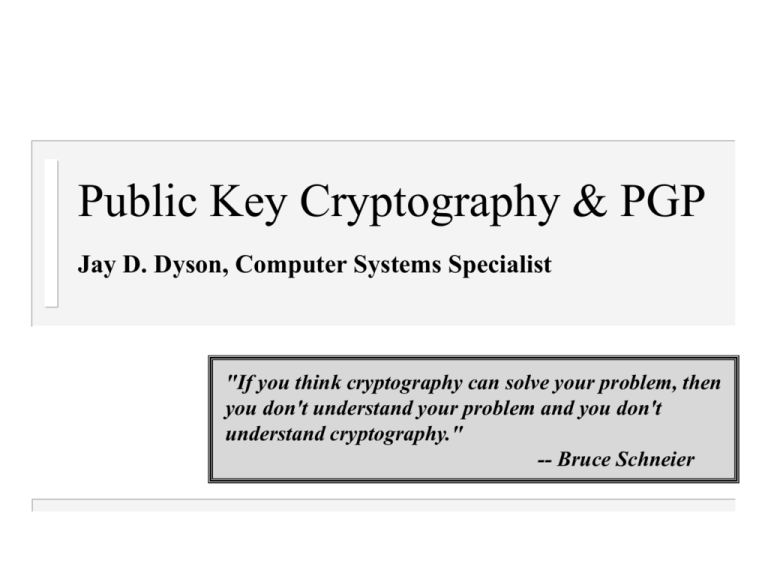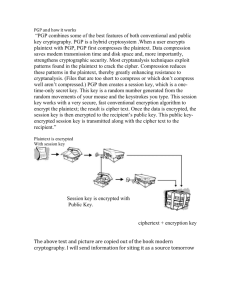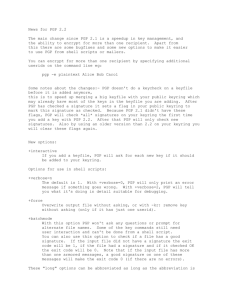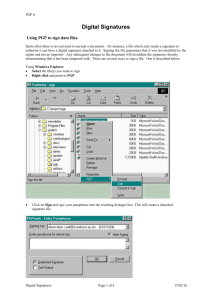
Public Key Cryptography & PGP
Jay D. Dyson, Computer Systems Specialist
"If you think cryptography can solve your problem, then
you don't understand your problem and you don't
understand cryptography."
-- Bruce Schneier
Overview of Cryptography
What is Cryptography?
Cryptography is an often misunderstood and
misused security tool. Today more than ever,
privacy is a necessary part of business
communications. The following is an overview of
public key cryptography and one of its more
widely-used implementations, Pretty Good
Privacy (PGP).
Copyright 1999 Jay D. Dyson
All right reserved
Overview of Cryptography
Terminology
Cryptographic/Cipher System - A method of disguising a
message so only authorized users may read it.
Cryptology - The study of cryptography.
Encryption - The process of converting plaintext into
ciphertext.
Decryption - The process of converting ciphertext back to
its original plaintext.
Cryptographic Algorithm - The computational procedure
used to encrypt and decrypt messages.
Cryptanalysis - The process of finding a weakness in, or
actual breaking of, a cryptographic system.
Copyright 1999 Jay D. Dyson
All right reserved
Overview of Cryptography
What’s the point?
Privacy - Would you be willing to send all of your
correspondence through the U.S. Mail on the back
of a postcard for all to read?
Data Integrity - Provides assurance that a
message or file has not been altered
Source Authentication - Provides a method to
identify the originator of a message or file
Copyright 1999 Jay D. Dyson
All right reserved
Types of Cryptographic Systems
Secret Codes
The simplest and oldest way to send a secret message to
someone. The code must be known to the sender or
recipient.
Code Phrase
True Meaning
My coffee is cold
Launch the missiles
Pass the cream
Don’t launch the missiles
Copyright 1999 Jay D. Dyson
All right reserved
Types of Cryptographic Systems
Ciphers
Substitution ciphers are the simplest type of cipher system.
Each letter of the alphabet is assigned to a number or
different letter.
ROT13 is a commonly used cipher.
A B C D E F G H I J K L M
1 2 3 4 5 6 7 8 9 A BC ...
Copyright 1999 Jay D. Dyson
All right reserved
Types of Cryptographic Systems
One-Time Pads
One-Time Pads uses a different key for a specific time
period.
Truly secure, no patterns evolve.
Most vulnerabilities due to human carelessness.
One-Time Pad - Shift each encrypted letter x places to the right
14 07 09 06 10 02 25 13 17 08 15
ABCDEFGHIJKLMNOPQRSTUVWXYZ
Encrypted Message
Decrypted Text
fazmyqbgnke
This is a test
Copyright 1999 Jay D. Dyson
All right reserved
Crypto Keys & Algorithms
General Concepts and Definitions
As a password is used to access a computer system, a
cryptographic key is a password or passphrase that is used
to unlock an encrypted message.
Different encryption systems offer different key lengths Just as a longer password provides more security
(WindowsNT excluded) the longer and more complex the
key is, the more security an encryption system provides.
A cryptographic algorithm is a mathematical function used
for encryption and decryption. Most algorithms contain a
certain number of “rounds.” This determines how many
times the text will be run through the algorithm
Copyright 1999 Jay D. Dyson
All right reserved
Cryptographic Methods
Secret Key (symmetric) Cryptography
A single key is used to both encrypt and decrypt a
message. A secure channel must be in place for users to
exchange this common key.
Secret Key
Plaintext Message
Secret Key
Encrypted Message
Copyright 1999 Jay D. Dyson
All right reserved
Cryptographic Methods
Public Key (asymmetric) Cryptography
Two keys are used for this method, the public key is used
to encrypt. The private key is used to decrypt. This is used
when it isn’t feasible to securely exchange keys.
Jay’s Public Key
Encrypted
Frank
Message
Clear Text
Jay’s Private Key
Copyright 1999 Jay D. Dyson
All right reserved
Cryptographic Methods
One-Way Functions
One-way functions:
Used to generate a fixed-length hash (also known as a message-digest)
of a file. This hash is essentially a ‘digital fingerprint’ of the file that
would be sent along with a document. The recipient would use the
same method to generate a hash. If the hashes do not match the file has
been altered.
Message
Crypto-Algorithm
5058f1af8388633f609cadb75a75dc9d
128 bit digital fingerprint
Copyright 1999 Jay D. Dyson
All right reserved
History of Public Key Crypto
In the beginning...
1976 Whitfield Diffie and Martin Hellman publish “New
Directions in Cryptography” which introduced the
idea of public key crypto systems. They also
introduce the idea of authentication by the use of a
one way function.
1977
Ronald L. Rivest, Adi Shamir and Leonard M.
Adleman develop a practical public key system
(RSA). It was this cipher that could be used for both
confidentiality and digital signatures.
Copyright 1999 Jay D. Dyson
All right reserved
Pretty Good Privacy (PGP)
Overview & History
PGP is a personal high-security cryptographic software
application that allows people to exchange messages or
files with privacy, authentication, and convenience. PGP
can be used to encrypt and digitally sign files and e-mail.
Developed by Phil Zimmerman in the mid ‘80s.
First version released on the Internet in 1991; got
immediate NSA attention and encountered legal issues on
its use of RSA and Merkle-Hellman cryptography patents.
Purchased by ViaCrypt in 1993 (they had RSA license).
Re-released in 1994 with RSAREF toolkit license.
Purchased by Network Associates in 1998.
Copyright 1999 Jay D. Dyson
All right reserved
Pretty Good Privacy (PGP)
Versions
PGP v2.6.2 (MIT PGP) is the current version for
DOS/UNIX platforms for use within the U.S. (v2.6.3i is
for use outside the U.S.)
PGP v5.x freeware is also available for DOS/Windows/
UNIX platforms although it is generally regarded as not as
secure as v2.x. Additionally, the v5.x freeware version is
not backward compatible with PGP v2.x.
PGP v6.x (NAI PGP) is the current commercial product
which offers “PGP Desktop Security,” “PGP Personal
Privacy,” and “PGP Freeware.” (The freeware version is
not backward-compatible with MIT PGP.)
Copyright 1999 Jay D. Dyson
All right reserved
Pretty Good Privacy (PGP)
Why Use It?
Privacy - Store and transmit your data so that only
select people may view their contents.
Integrity - Ensure your files, data, and
applications have not been modified without your
consent.
Authentication - A way to verify that people
actually are who they claim to be.
Copyright 1999 Jay D. Dyson
All right reserved
Pretty Good Privacy (PGP)
Basic Usage & Key Management
To encrypt file with recipent's pubkey: pgp -e
textfile her_userid [other userids]
To sign a file with your secret key:
pgp -s textfile [-u your userid]
To sign a file with your secret key, and
encrypt it with recipent's pubkey:
pgp -es textfile her_userid [-u your_userid]
To decrypt or check a signature for a
ciphertext (.pgp) file: pgp ciphertextfile
To produce encryption/signature output in ASCII
for email, add the -a option to above options.
To generate your own unique public/secret key
pair: pgp -kg
To add a key file's contents to your public or
secret key ring:pgp -ka keyfile [keyring]
Copyright 1999 Jay D. Dyson
All right reserved
Pretty Good Privacy (PGP)
Basic Use & Key Management (Continued)
To remove a key or a user ID from your public
or secret key ring: pgp -kr userid [keyring]
To edit your user ID or pass phrase:
pgp -ke your_userid [keyring]
To check signatures on your public key ring:
pgp -kc [userid]
To sign someone else's public key on your
public key ring:
pgp -ks her_userid
To view the contents of your public key ring:
pgp -kv
Copyright 1999 Jay D. Dyson
All right reserved
Pretty Good Privacy (PGP)
Generating a Key
To create a new key: pgp -kg
Select option 3: 1024 bits-"Military" grade, slow,
highest security
Enter a user ID for the new key (usually name followed by
email address: Joe Public <jpublic@public.com>
Enter a pass phrase. This phrase is used to encrypt your
secret key.
* do not use the same password or pass phrase that is
used on another system
* do not use common words or proper names
* do not use any single word that may be contained in a
dictionary
Copyright 1999 Jay D. Dyson
All right reserved
Pretty Good Privacy (PGP)
Generating a Key
Use an actual phrase and not just a single password.
Example of a good pass phrase: “Sew ewe theenk ewe kan
haq mie passfraze bye heereeng mee saye it 2 tymez?”
NOTE: passphrases are case-sensitive!
Do not use lines from history, popular movies or books!
The last step is to input random text in order to generate a
series of random bits. This is done by measuring the time
intervals between keystrokes.
The random bits are used to create the user’s keys.
The generated keys will be placed on your public and
private keyrings.
Copyright 1999 Jay D. Dyson
All right reserved
Pretty Good Privacy (PGP)
PGP Public Key Certificates
PGP stores each public key in a key certificate
which contains:
– The public key itself.
– The ID of the key’s creator (usually name &
email address).
– The date the key was created & expiration date.
– A list of digital signatures provided by people
who attest to the key’s authenticity.
Copyright 1999 Jay D. Dyson
All right reserved
Pretty Good Privacy (PGP)
Encrypting & Decrypting Files
To encrypt a file with a recipient’s public key:
pgp -e <filename> <user ID>
This will produce the file filename.pgp Only the
recipient can decrypt the file using their private key.
Note: Whenever encrypting text files to send via the Internet also use
the ‘a’ option for ASCII output
The recipient can decrypt the file with:
pgp filename.pgp
They will then be prompted to enter their private key pass
phrase.
Copyright 1999 Jay D. Dyson
All right reserved
Pretty Good Privacy (PGP)
Digital Signatures
To add a digital signature to a file:
pgp -sta filename
The user will be prompted to enter their pass phrase.
The file <filename.asc> will be created which contains the
digital signature of the sender.
The recipient can verify the digital signature to ensure the
files contents have not changed: pgp filename.asc
Copyright 1999 Jay D. Dyson
All right reserved
Pretty Good Privacy (PGP)
Digital Signatures
The recipient will be notified if the file has a good
signature:
Good signature from user "Joe Public<jpublic@public.com>".
Signature made 1998/07/27 04:29 GMT
If the file had been modified even by one byte the recipient
would be advised that the signature was not valid:
Bad signature from user "Joe Public <jpublic@public.com>".
Signature made 1998/07/27 04:29 GMT
Copyright 1999 Jay D. Dyson
All right reserved
PGP Enhancements
General Notes
Utilities and filters are available that make PGP
easier to use for the end-user. (Please see
http://techreports/~jdyson/pgp4pine/index.html)
NAI PGP functions as a plug-in to Eudora and
other popular Mail User Agents (MUAs). NAI
PGP also has a number of disk utilities for digital
signatures and encryption.
There is also PGPfone for voice communications,
but that’s another story altogether...
Copyright 1999 Jay D. Dyson
All right reserved
Public Key Crypto & PGP
Suggested Reading
Applied Cryptography (Bruce Schneier)
John Wiley & Sons, 1996 - ISBN: 0-47111-709-9
Attrition.Org Cryptography Archives
http://www.attrition.org/~wrlwnd/crypto/
International PGP Home Page
http://www.pgpi.org/
MIT PGP Home Page
http://web.mit.edu/network/pgp.html
NAI PGP Home Page
http://www.pgp.com/
PGP - Pretty Good Privacy (Simson Garfinkel)
O’Reilly & Associates, 1995 - ISBN: 1-56592-098-8
PGP RSA vs. PGP DH/DSS FAQ
http://www.scramdisk.clara.net/pgpfaq.html
Copyright 1999 Jay D. Dyson
All right reserved






